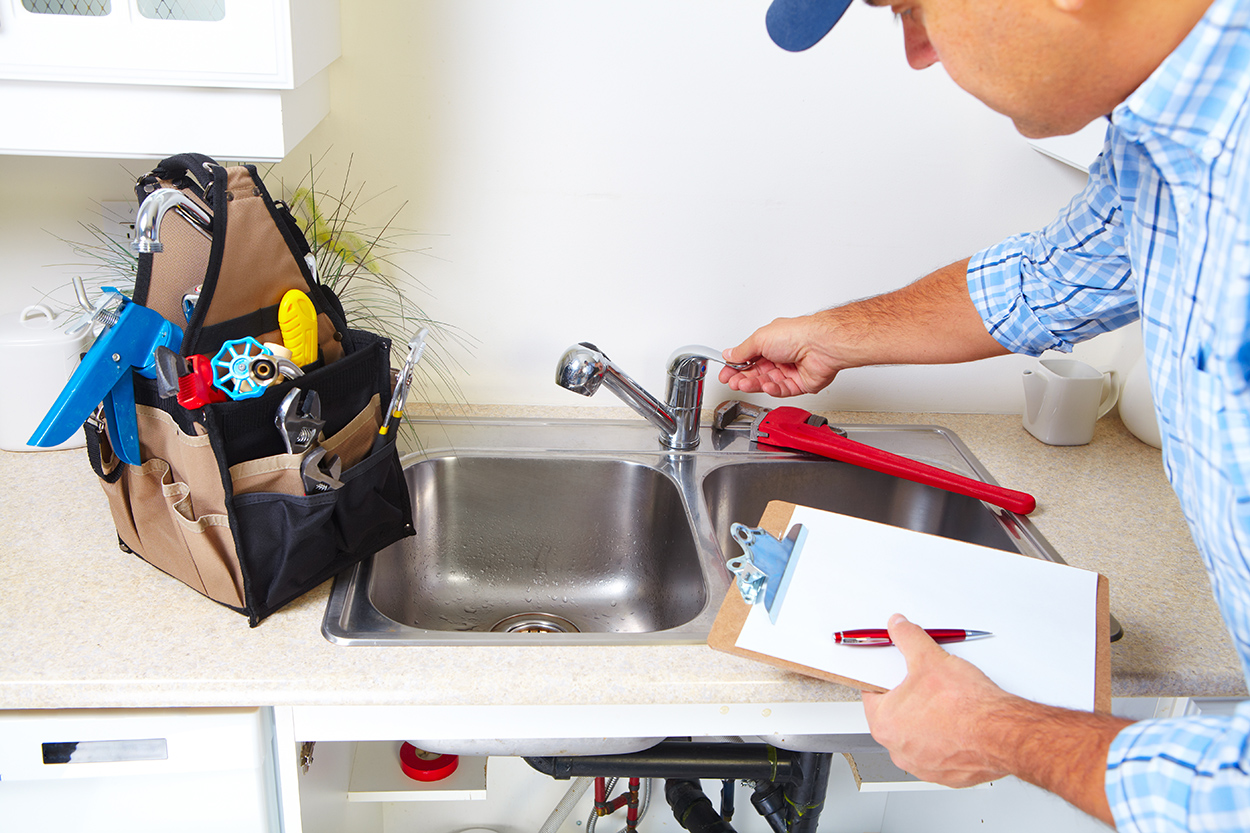
How to unblock a drain
There’s not a plumbing system in the world that is immune to the occasional blockage, it’s a simple fact, with blockages occurring frequently as the result of the many materials and substances we wash, flush, and dump through our systems every day. Some homes or businesses may be more prone to suffering the occasional blockage than others as a result of several factors, such as the age and layout of your plumbing system, how many solid or sedimentary materials you wash into your drains and pipes, as well as any vegetation which can wind roots into your system (fig trees, we’re looking at you).
A blocked system can be a real inconvenience, especially if you’re a business or a busy homeowner stuck with overflowing drains or a toilet which won’t flush. But not all blockages call for professional assistance: with a few tools and a bit of spare time, you can probably get the job done by yourself.
We’ve got a few tried and tested techniques for clearing blocked drains, clogged toilets, slow-running floor drains, and even kitchen sinks! However, you should take this advice with a grain of salt and remember that if you fail to clear the blockage yourself after a couple of tries, you should call your expert drain-cleaning service/plumber to get the job done. This is important to remember, as pipes and fixtures can be damaged by overzealous amateur attempts to clear more serious blockages.
You’ll need some tools
Unclogging a simple blockage only requires a few tools, most of which can be bought at your local home centre or hardware store. We’ll start with the obvious: you’ll need a plunger. You can pick up a good one for $5-$15, but make sure you choose a size which fits the fixture or drain you’re trying to unblock. A good plunger can often be all that’s required to clear a minor blockage in most domestic fixtures, such as baths, toilets, sinks and shower drains. A worthwhile investment for any small business or homeowner, having a plunger on hand could be the difference between hours of inconvenience or a few minutes work to clear your clogged fixture. In fact, if you call a plumber straight away, chances are we’ll have a go at plunging your fixture before we get any of the other tools out.
If you’re unlucky enough to have a blockage which has occurred further down the length of your system, a plunger might not do the job. Luckily for you, there is a tool designed specifically to target deeper or thicker blockages; the plumbing snake, also known as an auger. A plumbing snake is basically a flexible length of steel cable fitted with a hand crank for easy dispensing and storage. Commercially available snakes come in lengths of up to 100 feet, but a 25 foot long snake is likely all you’ll need for most hard-to-reach domestic blockages. These too can be bought at your local hardware store, for between $15 and $20.
The closet auger is a variety of plumbing snake which is specifically designed to unclog blocked toilets. With a more rigid shaft and angular head for easy insertion, a closet auger can slip through most toilet traps to get to wear the blockage might be hiding – one of these will set you back between $15 and $40.
For more serious blockages, such as those which have built up over a long period of time in larger pipes, or those caused by entangled tree roots, an electric power auger may be required. This is what your plumber might use to fix a serious blockage, but you can rent one yourself from some hardware retailers or rental agencies for between $20 and $100 per-day (plus a deposit). Power augers use an electric motor to cut through dense blockages, but be aware that if broken pipes are present you may get the auger stuck. For this reason it is important that you are sure that the blockage is caused by built up material and not broken pipes, and that you know how to safely dispense and retrieve the auger cable before you use it on your own.
Blocked toilet
These can be the most annoying domestic blockages, especially if you’re experiencing problems with backflow. Luckily, most toilet blockages are the result of something becoming lodged in the up-curving trap, which means you might be able to dislodge it with your trusty plunger. If not, you will need to use a plumbing snake or a closet auger, especially if the blockage is situated further around the bend.
Commence the operation by inserting the end of the plumbing snake into the toilet bowl, with the tip turned upwards. Try and hold the shaft steady as you unwind the snake. Continue cranking until the shaft has reached about three feet deep into the fixture. Once you’ve cranked the cable out that far, start to pull it back in whilst cranking the handle simultaneously. Once you’ve done this once or twice, flush the toilet to see if you managed to clear the blockage. If not, repeat the process another two times, aiming up the left and right hand sides of the trap. Attacking the blockage from three sides is likely to dislodge it, but if it happens to be something more solid, you will probably need a power auger to deal with it once and for all.
Blocked floor drain
In a domestic situation, you might have floor drains located in your garage, laundry, or basement, put there to carry away water from air-conditioning units, heaters, washing machines, or even snow melt in some areas. If you’re a small business operating a kitchen, or any other workspace which requires lots of cleaning with water, you’re floor drains may be especially prone to blockages.
Over time, sedimentary materials such as dirt, sand, laundry lint, soap, and bacteria can collect in the drainpipe, forming a blockage. If the drain is still working, but water is being carried away slowly, give your plunger a try. It may be that there’s a soft build up of material in the drain which could be dislodged relatively easily. If this doesn’t work, your problem might originate from deeper within the drainpipe. You will likely require an electric power auger with a cable length of 50 feet or more to break through any deep-sitting blockage.
You’ll need to start the unblocking process by removing the strainer which covers the hole of most floor drains. Once the strainer’s off, look for the clean-out plug, which should be located somewhere on the side of the drain’s basin. Some drains don’t have a clean-out plug, which means you will need to feed your cable through the drain’s trap, which will give you less manoeuvrability. Use a wrench to help get the plug out so that you can insert the auger’s cable into the drainpipe. Once this is done, plug in your auger and ensure that the motor and spooling unit are placed next to the drain. Use both hands to feed the cable into the drainpipe until you feel a blockage, pressing down on the foot pedal to cut through any obstructing material. When you reach the main blockage, you may be able to feel resistance in the cable or hear the motor struggling to power the blades. At this point, switch off the motor and reverse the auger’s rotation. Switch it on again and pull the cable back towards you a few feet, then push it back down in a clockwise motion. Repeat this process a few times until you have cleared whatever was causing the blockage. Now it’s time to carefully draw the cable back out of the drainpipe and unplug the electric power auger. Once this is done, you should pour some hot water down the drain (at least a few bucketfuls) to clear any remaining material. If the water is still moving slowly, give it another go, and if that fails, call your expert plumber/drain-unblocking professionals!
CAUTION: If your drain has a clean-out plug, make sure that you put it back on once you have cleared the blockage! Failing to do so could result in dangerous sewer gases entering your home or business via the drain.
Blocked bath/shower drain
You might notice that your shower or bathtub has started to drain more slowly, causing water to build up around your feet while the water is running. This is a sign that a blockage is building beneath your bath/shower fixture and that you’ve got work to do. Bathroom drains are prone to clogging up with the soap and hair which we wash down those drains every day. Luckily, these blockages are often the easiest to deal with owing to the fact that they are usually the result of a build up rather than a more serious problem.
To begin with, you might want to try a chemical drain cleaner, as this will dissolve most soap and hair which might be causing your drain to clog up. However, chemical means are not preferred when dealing with bathroom blockages, as there is a risk that the chemicals could burn your skin if they happen to wash back out of the drain. To perform a mechanical unblocking, you should remove the screen from the top of the drain (if there is one), and clean it thoroughly to remove any built up material. Your shower or bathtub may have a pop-up drain; if it does, use the lever to open it up and clear any material which has built up near the surface. Sometimes this is enough to get your drain working again, but if not, you should reach for your trusty plunger. Place wet rags on top of the holes under the overflow plate, and start plunging the drain.
If plunging fails to clear the blockage, you should move to the plumbing snake we discussed earlier. Remove the overflow plate and start to feed your cable down whilst rotating it steadily and cranking the handle – about 60 centimetres should do it. Hopefully you will feel the blockage; if you do, keep cranking until the plumbing snake has reached the P-trap below your bathtub/shower. Once you’ve broken up the blockage, withdraw the cable slowly and wash away any remaining material with a few bucketfuls of hot water. If your drain is cleared, you’re ready to replace the overflow cap and drain screen and start enjoying your bathroom again!
Blocked sink
Sinks can often become blocked thanks to the food and other material we frequently wash down them. Again, as is the case with most bathroom blockages, a blocked sink is relatively easy and you can probably fix the problem yourself in a few minutes. Grab your trusty plunger, as it can probably clear any minor blockage. Before you start plunging, fill the sink half-full with water, then plunge vigorously a few times. Pull the plunger off the drain in a swift motion and see if it drains quickly.
Your sink may be a double-bowl. If this is the case, you should stuff a wet rag into one of the holes and plunge the other one. The rag is used to ensure that pressure is mounted on the blockage when you plunge.
If plunging doesn’t clear your blocked sink, you might need to use a plumbing snake. This can be a bit of an ambitious job, as shouldn’t put the snake directly down the sink’s fixture. Before you use the plumbing snake, you will need to remove the sink trap with a pipe wrench (you might be able to do this by hand if you have a PVC trap with bigger couplings). Let the water from the sink pour into a bucket, and check that the trap itself is clear of blockages. A horizontal trap arm should be protruding from the wall’s stub-out, you will need to remove this. Then you are free to begin feeding the plumbing snake into the stub-out, working the crank and guiding the cable until you feel pressure. Start withdrawing the cable and trying to tighten the lock-screw, repeat this process until you feel that you have broken up whatever material was causing the blockage.
If at any point you feel that the plumbing snake has become bogged or caught on something, you should start rotating it the other way and pulling it back. Once you have completed the snaking process, withdraw the cable and put the trap arms and sink trap back in place. Run hot water through the sink to flush it and make sure that the blockage has been removed. If it is draining slowly, it may be that the broken up blockage has turned into loose material which is reducing the flow. If this happens to you, fill the sink half-full with water and use the plunger to clear the loose material before flushing it out with hot water again.












